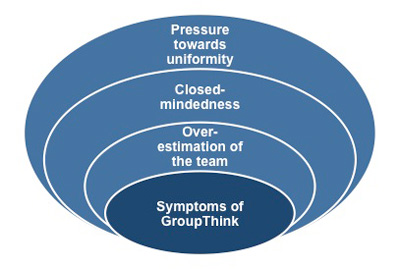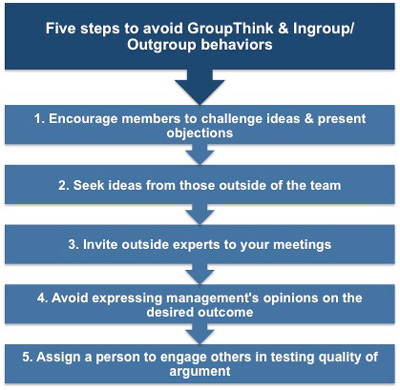GroupThink and In-group Behavior
GroupThink was a term coined in 1972 by Irving L. Janis, an American research psychologist and professor at the University of California. He described it as an observable fact that groups tend to ignore or discredit information that does not fit in with the group's ethos and beliefs. There are several famous historical events where GroupThink has been implicated. Two examples are Pearl Harbor and the Challenger Space Shuttle disaster.
In 1941, the Americans received several reports that the Japanese were preparing for an attack on Pearl Harbor. But as this was the headquarters of the US fleet and was believed to be secure these warnings were ignored. The result was that on December 7 the US fleet sustained extensive damage, with devastating numbers killed. The event brought the United States into World War II.
In 1986, the space shuttle Challenger broke apart 73 seconds into its flight, causing the deaths of its seven crew members. The Rogers Commission investigation found that NASA's organizational culture and decision-making processes had been key contributing factors to the accident.
They discovered that NASA managers had known about a potentially catastrophic flaw in the design of the rocket booster since 1977, but had failed to address it properly. The managers also disregarded warnings from engineers about the dangers posed by the low temperatures on the morning of the accident, and failed to adequately report these technical concerns to their superiors.
 |
Such events are extreme examples of a situation where teams or groups of people felt that maintaining harmony and consensus within the group was more important than realistically appraising alternative courses of action. Janis identified three basic symptoms of GroupThink:
- Overestimations of the Team - the members believe that their moral code is high and as such anything they decide is good. This feeling of goodness also prevents fear of failure during a crisis.
- Closed-mindedness - members construct rationalizations in order to discount warnings and other forms of negative feedback that, taken seriously, might lead group members to reconsider their assumptions. Team members view groups outside of their team in a negative way and this enables the team to minimize decision conflicts between ethical values and expediency.
- Pressures toward Uniformity - members don't want to deviate from the consensus of the group so keep quiet about any misgivings they may have. This behavior minimizes any doubts they have themselves, and they block from their minds any information that brings the group's beliefs into question. This silence is seen as acceptance, and any member expressing doubt comes under severe pressure to conform to the shared values.
As a manager you are mostly likely to come across the issue of GroupThink if you are working in a highly cohesive team that is under considerable pressure to make a decision or meet a deadline. Such pressures can result in team members preferring to seek consensus rather than realistically appraise alternative courses of action.
This means that decisions made in this way by a GroupThink team are unlikely to achieve a successful outcome. You should view GroupThink as a continuum rather than something that is either present or absent within a group or team. Remember, some disagreement is a good thing as it demonstrates that issues have been thoroughly debated prior to a decision being reached.
You also need to be mindful that if your team has been together for a long time, or has been through a stressful time, it may exhibit what sociologists refer to as the in-group /out-group phenomenon. A primary purpose of team building is to create an 'in-group '; this is perfectly reasonable, and helps the team to overcome internal differences in order to confront external problems.
However, one of the unintended consequences of this bias is that team members may come to view people outside of the team as an 'out-group ,' towards which they feel contempt or opposition, or against which they desire to compete. If left unchecked, this behavior can become very destructive and have an adverse effect on the team's performance. It can also damage the team's image and standing within the organization.
You will need to ensure that you educate and illustrate to the team their own and others' importance in achieving the organization's objectives. Your best approach in defeating GroupThink and in-group /out-group behaviors is to follow five steps.
 |
These steps are:
- Team leaders should encourage each member to challenge ideas and present objections.
- Team members should talk to and solicit ideas from people outside the group.
- Outside experts should be invited to attend some team meetings.
- Management should avoid expressing opinions about the preferred outcome.
- Assign a Devil's Advocate at critical meetings. This person seeks to engage others in testing the quality of the original argument so any weaknesses can be identified. The original position is then either improved or abandoned.
Whether you inherit a team exhibiting GroupThink or in-group /out-group behavior, or you see the early signs of this behavior becoming a pattern in your team, you need to create a working environment where openness, participation, and new ideas are encouraged and welcomed by all.
This stage of the process of turning your team around should not be rushed and can take up to 12 months to complete. Once you have developed your team so that they want to perform their tasks as well as have the right skills and knowledge to perform the tasks well, this will become a constant cycle of management activity.
You may also be interested in:
Team Performance Problems | Herzberg's Hygiene Theory of Motivation | Common Fallacies About Leading Teams | Six Silent Barriers to Performance | Five Key Team Performance Factors | Matrix Management Issues | Qualities of Leadership.



